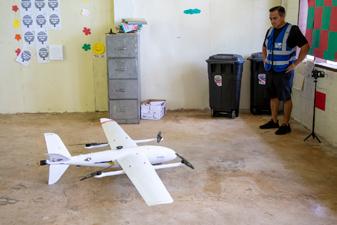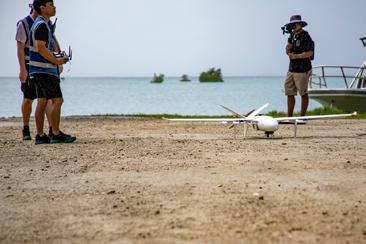
3 minute read
UOG HoveRx project demonstration a great success despite uncooperative weather
By Bill Jaynes The Kaselehlie Press
April 2, 2023
Advertisement
Pohnpei—Representatives of the University of Guam’s Professional Master of Business Administration Cohort XVIII came to Pohnpei for what they called their final “capstone project.” The trip was for a proof-of-concept of the project, which they entitled “HoveRx.” On April 2, the intention was to demonstrate the ability to utilize drones for the delivery of preventative healthcare items to remote areas in the State of Pohnpei.

Members of the team did a successful flight from Seinwar Elementary School in Kitti to and from Ahnd Atoll (often spelled “Ant”) on April 1, a distance of over 10 miles. Unfortunately, the weather did not cooperate on April 2 at the scheduled time for the demonstration. The intention on that day was to fly the large drone to Ahnd Atoll, a distance of over 10 miles, where other members of the team were stationed to receive it. The large drone would make the return trip on the following day.
The drone is actually waterproof, so it can fly in the rain, which was definitely present on the day of the demonstration. It can also fly in fairly high winds, but on the day of the demonstration, the wind that accompanied the storm system over Pohnpei at the time was too unpredictable to risk the full flight. Instead, the crew members demonstrated some of the flight capabilities of the drone and performed a drop of a sevenpound package containing sample preventive medicines on the beach behind Seinwar Elementary School.

Local operators recorded the flight using their consumer-level drones. They were dwarfed in the sky and on the land by the size of the drone that the UOG team used for their demonstration. One of the pilots said that the drone they used had a flight speed of approximately 50 miles per hour and a battery life of approximately three and a half hours. The combination of those two might lead readers to believe that would give the drone a range of approximately 150 miles, but as the pilot said, that would be right on the outer edge of the drone’s capability, which no drone operator likes to push. The range also depends on conditions in the air that it flies through. Higher winds would mean slower operating speed and higher battery drain.

The drone is much more stable in flight than consumer drones due in large part to the addition of wings to the four propellors.
The team explained the purpose of the operation and held a free raffle of UOG prizes before and after the demonstration.
“This team has worked hard for the last nine months in the UOG PMBA program, and this project really is a culmination of everything we’ve learned,” HOVERx Project manager Hazel Estrellado told the Saipan Tribune. “We are excited to see our plans come to life, especially for a project like HOVERx that has the potential to impact so many people.”
Despite the lack of the weather’s cooperation, the cohort could very easily call their demonstration and the previous day’s flight to Ahnd Atoll and back a great success.
The cohort’s capstone project demonstration in partnership with Bella Wings Aviation was supported by a number of donors, including PFM, IT&E, Citadel, IP&E, Outerbridge Technical Solutions, AK, AM Insurance, and Cohort friends and family.


